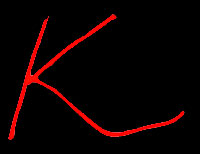
|
EXHIBIT CHAPTERS:
|
Enraged at the London critics and ready to return to the United States after four decades, Kitaj left England in 1997. He and Max moved to Los Angeles which, Kitaj observed, “became my hometown over the years.” They settled in Westwood, in close proximity to son, Lem, and his family. Kitaj adopted a self-described “hermetic” existence, hewing to a regimented daily routine of writing, painting, and reading, with an hour available to receive visitors. In 2003, the LA Louver Gallery hosted a show of Kitaj’s work called “Los Angeles Pictures.” The show gave expression to the painter’s obsession with his late wife: “Sandra and I became Lovers again, after her death, in my old age in Los Angeles.” Kitaj offered additional insight into his state of mind during this period in the catalogue to the Louver exhibit: “I’m still studying the Jewish Question. It may be the Promised Land.” In the wake of the Louver show, one reviewer asserted that Kitaj was “America’s greatest figurative painter,” a telling contrast to the judgment of the London critics. Although far less social than in his London years, Kitaj maintained contact with friends in Europe and the United States through ample correspondence. His many letters and postcards were written in a distinctive block-letter style and red pen. He also gave voice to a wide range of thoughts and feelings on small paper napkins from his favorite Westwood café, the Coffee Bean. Ever the collector, Kitaj saved these napkins, as he did clippings and articles that made reference to his work, scholarly papers, and books relating to art, art history, and Jewish thought. He amply annotated these research materials with his signature red pen. The Second Diasporist Manifesto and a forthcoming memoir were also written in the same characteristic style. |
|
|||||||||||||||||||||||||||||||
Kitaj Exhibit Home
|
UCLA Library Special Collections Exhibits
|
UCLA Library Special Collections |
UCLA Library | UCLA
Home
© 2010 by the Regents of the University of California. All rights reserved.















